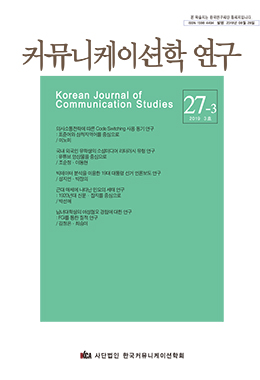본 연구에서는 1920년대 신문과 잡지에 수록된 민요를 통하여 당대의 세태(世態)를 고찰해 보았다. 먼저, 신문물에 대한 수용과 동경을 살펴보았다. 1920년대 민중들은 <아리랑 아리랑 아라리요>에서 근대 문화의 대명사인 자동차가 달리기 위한 교통로인 ‘신작로’를 부정적인 측면에서 수용하면서도 ‘자동차’라는 신문물을 동경하는 모습을 보였다. <검뎡양산흰저고리>에서 당시 여학생들은 복장을 통하여 일반 민중들의 부러움(동경)의 대상이 되었다.
다음으로 당대의 다양한 문화를 엿볼 수 있었다. <예수나미덧더면>에서는 우리 나라에 기독교가 유입되면서 기독교 문화와 교리(敎理)가 매우 긍정적으로 작용했던 것을 알 수 있었다. 즉 예수나 믿었더라면 천당에 갈 것인데, 광산에서 얌전하지 못한 노릇을 해서 불량분자가 된 것을 후회하였던 것이다. <밀매노래>와 <베틀가>에서 민중들의 농촌문화, <장타령>을 통하여 민중들의 상업문화를 포착할 수 있었다. 또한 <우리품행이얼마나방정한지>에서 민중들의 빈궁한 삶의 모습, 즉 생활문화를 살필 수 있었다.
마지막으로 당대의 다양한 풍속을 파악할 수 있었다. 즉 1920년대 당시 농촌의 풍속이 잘 드러난 <사승노래(삼 삼는 노래)>, 민속놀이를 할 때 부르는 <놋다리 노래(답교가)>와 <기와 노래(와가)>에서도 당시 민중들의 풍속을 알 수 있었다.
이 논의를 통해 1920년대 신문과 잡지에 수록된 민요 사설의 일면을 살필 수 있었다. 이는 우리나라에 당대 신문물이 유입되면서 부정적인 측면과 함께 신문물을 수용할 수밖에 없었던 농민들의 마음과 다양한 문화와 풍속을 포착했다는 점에서 의의가 있다고 하겠다.
In this research, we have looked around the social conditions and the custom of the era through the folk songs included in the modern media in the 1920’s. First, we looked around the accommodation and longing for new products of civilization. In the 1920’s, people in < Arirang arirang arariyo >(<아리랑 아리랑 아라리요>) accommodated ‘sinjakros(newly constructed roads)’ with negative side that were the traffic route for an automobile to run which was the pronoun of modern civilization, but they were shown to long for the new civilization of an automobile(car). In < Geomjeong yangsan hin jeogori >(A black parasol and a white traditional jacket) girls of that era became the objects of envy through costumes.
Next we could get a sense of the various culture of that time. In < Yesuna Mideotdeoramyeon >(If I believed in Jesus) we could understand that Christian culture and doctrines worked very positively when Christianity flowed into Korea. Namely they regretted that they became bad guys after their untidy role in the mine. They thought they could go to the paradise if they believed in Jesus. We could capture people’s rural culture in < Milme nore >(Wheat grinding song) and < Betlga >(Loom song), and people’s commercial culture in < Jang taryoeng >(marketplace ballad). And we could also look around people’s destitute look of life that is living culture in < Uri ttaleu pumhaengi eolmana bangjeonghanji >(How upright our daughter’s conduct is!).
Finally, we could grasp various custom of those days. And we could see people’s culture of the time, in < Sam samneun nore >(Hemp spinning song) where 1920’s rural culture is exposed, and in < Notdari nore >(Treading bridge song) and < Giwa nore >(Roof tile song) that is sung when folk game is played.




